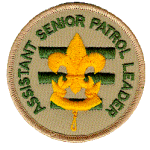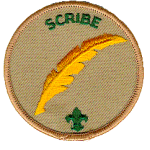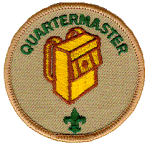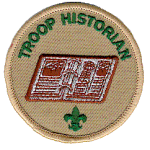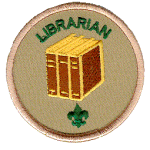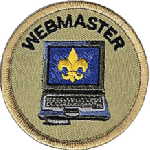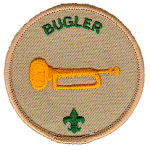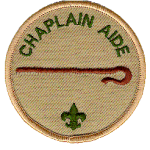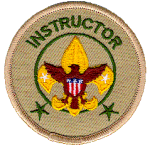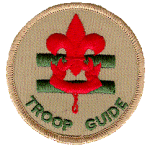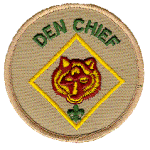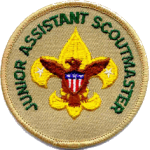Listed below are the responsibilities for the leadership positions within the Troop. It is important to note that not every position may be in use each election. It will depend on the needs and size of the troop to determine which positions are in use, in some cases, more than one scout may hold the same position to better distribute the workload. Some positions may be elected by the troop or patrol, others may be appointed by either the Senior Patrol Leader or the Scoutmaster.
Senior Patrol Leader
The senior patrol leader is the top leader of the troop. She is responsible for the troop’s overall operation. With guidance from the Scoutmaster, she takes charge of troop meetings, of the patrol leaders’ council, and of all troop activities, and she does everything she can to help each patrol be successful. She is responsible for annual program planning conferences and assists the Scoutmaster in conducting troop leadership training. The senior patrol leader presides over the patrol leaders’ council and works closely with each patrol leader to plan troop meetings and make arrangements for troop activities. All members of a troop vote by secret ballot to choose their senior patrol leader. Rank and age requirements to be a senior patrol leader are determined by each troop, as is the schedule of elections. During a Scout’s time as senior patrol leader, she is not a member of any patrol but may join with a patrol during meals at camping events and other activities.
Assistant Senior Patrol Leader
The assistant senior patrol leader works closely with the senior patrol leader to help the troop move forward and serves as acting senior patrol leader when the senior patrol leader is absent. Among her specific duties, the assistant senior patrol leader trains and provides direction to the troop quartermaster, scribe, historian, librarian, instructors, and Order of the Arrow representative. During her tenure as assistant senior patrol leader she is also not a member of a patrol, but may be joined with a patrol for camping events and other activities. Large troops may have more than one assistant senior patrol leader, each appointed by the senior patrol leader.
Troop Scribe
The scribe is the troop’s secretary. Though not a voting member, she attends meetings of the patrol leaders’ council and keeps a record of the discussions. She cooperates with the patrol scribes to record attendance and dues payments at troop meetings and to maintain troop advancement records. A member of the troop committee may assist her with this work
Troop Quartermaster
The quartermaster is the troop’s supply boss. She keeps an inventory of troop equipment and sees that the gear is in good condition. She works with patrol quartermasters as they check out equipment and return it, and at meetings of the patrol leaders’ council she reports on the status of equipment in need of replacement or repair. In carrying out her responsibilities, she may have the guidance of a member of the troop committee.
Historian
The historian collects and preserves troop photographs, news stories, trophies, flags, scrapbooks, awards, and other memorabilia and makes materials available for Scouting activities, the media, and troop history projects.
Librarian
The troop librarian oversees the care and use of troop books, pamphlets, magazines, audiovisuals, and merit badge counselor lists. She checks out these materials to Scouts and leaders and maintains records to ensure that everything is returned. She may also suggest the acquisition of new literature and report the need to repair or replace any current holdings.
Webmaster
The troop webmaster is responsible for maintaining the troop’s website. She should make sure that information posted on the website is correct and up to date and that members’ and leaders’ privacy is protected. A member of the troop committee may assist her with this work.
Bugler
The bugler plays the bugle (or a similar instrument) to mark key moments during the day on troop outings, such as reveille and lights out. She must know the required bugle calls and should ideally have earned the Bugling merit badge. The Bugler helps keep the unit on-time and organized.
Chaplin’s Aid
The chaplain aide assists the troop chaplain (if there is one, usually an adult from the troop committee) in serving the religious needs of the troop. She ensures that religious holidays are considered during the troop’s program planning process and promotes the BSA’s religious emblems program. This scout may be responsible for invocations or benedictions at meetings and events.
Instructor
Each instructor is an older troop member proficient in a Scouting skill. She must also have the ability to teach that skill to others. An instructor typically teaches subjects that Scouts are eager to learn—especially those such as first aid, camping, and backpacking—that are required for outdoor activities and rank advancement. A troop can have more than one instructor.
Leave No Trace Trainer
The Leave No Trace Trainer specializes in teaching Leave No Trace principles and ensuring that the troop follows these principles on outings. She can also help Scouts earn the Leave No Trace award. She should have a thorough understanding of and commitment to Leave No Trace. Ideally, she should have completed Leave No Trace training and earned the Camping and Environmental Science merit badges.
Outdoor Ethics Guide
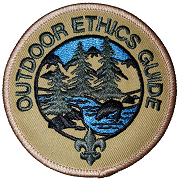
The outdoor ethics guide helps the troop plan and conduct an outdoor program that emphasizes effectively practicing the principles of outdoor ethics. The guide works to help Scouts improve their outdoor ethics decision-making skills to minimize impacts as they participate in outdoor activities. They support Scouts who are working to complete the relevant requirements for the Tenderfoot, Second Class and First Class ranks.
Troop Guide
The troop guide is both a leader and a mentor to the members of the new-Scout patrol. She should be an older Scout who holds at least the First Class rank and can work well with younger Scouts. She helps the patrol leader of the new-Scout patrol in much the same way that a Scoutmaster works with a senior patrol leader to provide direction, coaching, and support. The troop guide is not a member of another patrol but may participate in the high-adventure activities of a Venture patrol.
Den Chief
The den chief works with a den of Cub Scouts and with their adult leaders. She takes part in den meetings, encourages Cub Scout advancement, and is a role model for younger Scouts. Serving as den chief can be a great first leadership experience for a Scout.
A Webelos den chief can help plan and assist with the leadership of Webelos den meetings and field activities. She can lead songs and stunts, and encourage Webelos Scouts to progress into a Scouts BSA Troop.
Patrol Leader
The patrol leader is the top leader of a patrol. She represents the patrol at all patrol leaders’ council meetings and the annual program planning conference and keeps patrol members informed of decisions made. She plays a key role in planning, leading, and evaluating patrol meetings and activities and prepares the patrol to participate in all troop activities. The patrol leader learns about the abilities of other patrol members and full involves them in patrol and troop activities by assigning them specific tasks and responsibilities. She encourages patrol members to complete advancement requirements and sets a good example by continuing to pursue her own advancement.
Assistant Patrol Leader
The Assistant Patrol Leader assists the patrol leader in his functions, and serves as the patrol leader when the patrol leader is not available.
Junior Assistant Scoutmaster
A Scout at least 16 years of age who has shown outstanding leadership skills may be appointed by the senior patrol leader, with the advice and consent of the Scoutmaster, to serve as a junior assistant Scoutmaster. These young women (a troop may have more than one junior assistant Scoutmaster) follow the guidance of the Scoutmaster in providing support and supervision to other youth leaders in the troop. Upon her 18th birthday, a junior assistant Scoutmaster will be eligible to become an assistant Scoutmaster.
Trained
Completing a program such as ILST (Introduction to Leadership Skills for Troops), NYLT (National Youth Leadership Training), Leave No Trace/Outdoor Ethics Trainer, Den Chief Training, or other qualified courses will help a Scout to have skills needed to help them perform their leadership position. Scouts who have completed the appropriate on-line and in-person training for their leadership positions may wear a “Trained” certification below their badge of office.


